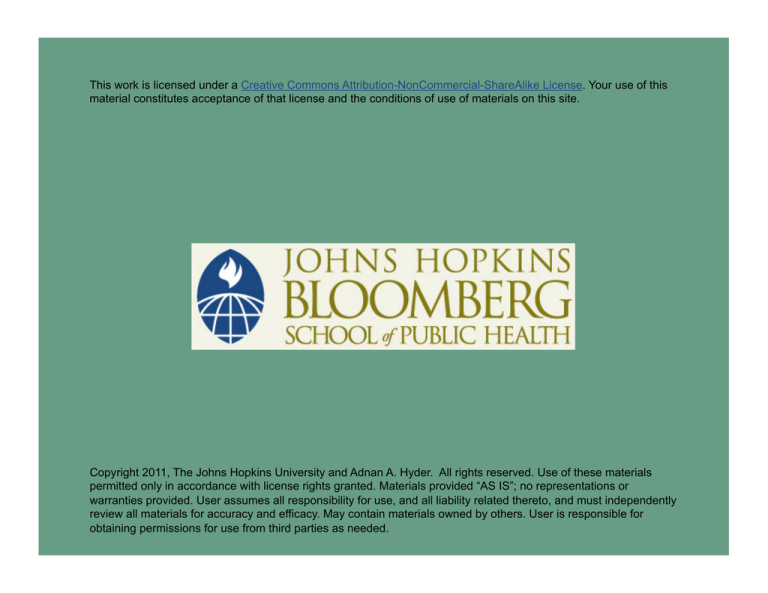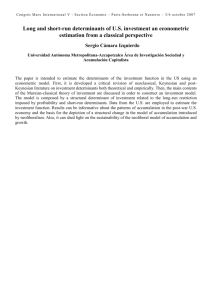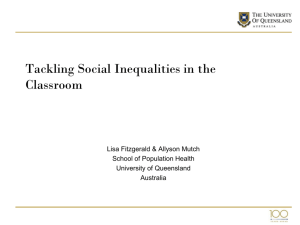
This work is licensed under a Creative Commons Attribution-NonCommercial-ShareAlike License. Your use of this
material constitutes acceptance of that license and the conditions of use of materials on this site.
Copyright 2011, The Johns Hopkins University and Adnan A. Hyder. All rights reserved. Use of these materials
permitted only in accordance with license rights granted. Materials provided “AS IS”; no representations or
warranties provided. User assumes all responsibility for use, and all liability related thereto, and must independently
review all materials for accuracy and efficacy. May contain materials owned by others. User is responsible for
obtaining permissions for use from third parties as needed.
Section B
Example 1: Global Level—Five-Step Process from WHO
The “Five Steps” in Priority Setting
Ad Hoc Committee, WHO 1996
What is the burden of
disease?
3
The “Five Steps” in Priority Setting
What is the burden of
disease?
Why does the burden
persist?
4
The “Five Steps” in Priority Setting
What is the burden of
disease?
Why does the burden
persist?
How cost-effective are
present interventions?
5
The “Five Steps” in Priority Setting
What is the burden of
disease?
Why does the burden
persist?
How cost-effective are
present interventions?
How cost-effective could
future interventions be?
6
The “Five Steps” in Priority Setting
What is the burden of
disease?
What is the present
resource flow for that
disease/risk?
Why does the burden
persist?
How cost-effective are
present interventions?
How cost-effective could
future interventions be?
7
A Practical Framework for Setting Priorities
A practical framework for setting priorities in health research
8
Example 2: Need to Integrate the
Determinants of Health
Global Forum for Health Research
Determinants of Health
HEALTH
Source: Global Forum for Health Research. (1999).
10
Determinants of Health
1. Individual, Family, &
Community Determinants
HEALTH
Source: Global Forum for Health Research. (1999).
11
Determinants of Health
1. Individual, Family, &
Community Determinants
HEALTH
2. Level of Health Ministry, Health
Research Institutions, Health
Systems & Services
Source: Global Forum for Health Research. (1999).
12
Determinants of Health
1. Individual, Family, &
Community Determinants
3. Level of
Other Sectors
than Health
HEALTH
2. Level of Health Ministry, Health
Research Institutions, Health
Systems & Services
Source: Global Forum for Health Research. (1999).
13
Determinants of Health
1. Individual, Family, &
Community Determinants
4. Level of
the Central
Government
3. Level of
Other Sectors
than Health
HEALTH
2. Level of Health Ministry, Health
Research Institutions, Health
Systems & Services
Source: Global Forum for Health Research. (1999).
14
Determinants of Health:
Where does research begin?
1. Individual, Family, &
Community Determinants
4. Level of
the Central
Government
3. Level of
Other Sectors
than Health
Global
Source: Global Forum for Health Research. (1999).
HEALTH
2. Level of Health Ministry, Health
Research Institutions, Health
Systems & Services
15
Example 3: Combined Approach Matrix
Global Forum and WHO
A Practical Framework for Setting Priorities
A practical framework for setting priorities in health research
17
Common Framework
Consolidates information
Promotes communication
Identifies linkages (basic-applied)
Places research into context
Assists identification of research areas (competitive advantages)
18
Points for Discussion: 1
Overall health research governance
- Diversity of actors
-
Define roles and collaboration principles
Fields of health research
1. Biomedical issues
2. Behavioral and community issues
3. Sectors outside health with profound influence on health
4. Good governance issues affecting health research
19
Points for Discussion: 2—The Research Loop
The research “loop”
1. Creation of knowledge
2. Validation of knowledge
3. Transformation into best practices
4. Dissemination
5. Identification of gaps and development of initiatives to fill the
gaps
6. Development of indicators to measure impact on health status
7. Feedback on orientation and design of future research—focus
on the weakest link(s)
20
Points for Discussion: 3—Remember the Goal of Research
How to increase the efficiency/effectiveness of the research “loop”
- Research (process, tool)
-
-
Knowledge (research outcome)
Change in health status of populations (global objective)
21
Communication and Information
Special Reports
Communication
with Decision
Makers
Web Site
Work with the Media
(North and South)
Strategic Papers
22
Reflections …
Identifying priorities is as important as conducting research itself
The process is a critical part, and the methods presented here are
tools
Burden of disease and summary measures are an important input,
and one of many
Consider a wide variety of areas, including conditions and risk
factors
23






